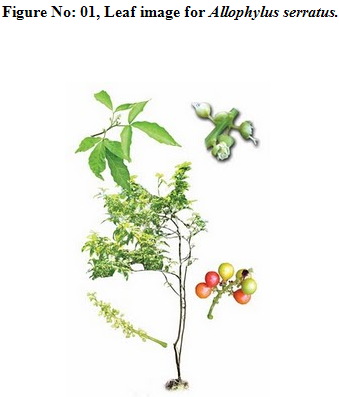ABOUT AUTHORS:
G. JYOTHI REDDY*1, A. SRILAKSHMI1, S.SINDHUJA2, N.K. SREE1, SK.AFSAR1, B.PRIYANKA1, R.E.AMRUTHA1
1 Department of Pharmacology, P. Rami Reddy Memorial College of Pharmacy, Kadapa, Andhra Pradesh, India.
2 Sri Padmavathi School Of Pharmacy, Tiruchanoor, Tirupathi, Andhra Pradesh, India
ABSTRACT
The ethanolic leaf extract of Allophylus serratus shown significant (p<0.05) antidiarrheal activity on gastrointestinal motility with castor oil- induced diarrheal model in rats. The results obtained revealed that the leaf extract possess pharmacological activity against diarrhoea and may possibly explain the use of the plant in traditional medicine. The extract tested at 200 and 400 mg/kg like the standard drug, loperamide significantly inhibited the frequency of defecation droppings compared to untreated control rats. This result is in support of previous claims in respect of antidiarrhoeal herbs.
Reference Id: PHARMATUTOR-ART-1242
INTRODUCTION
Diarrhoea is a common digestive disorder that virtually all people will suffer at some stage during their lives. The definition of diarrhoea varies but it can generally be taken to mean increased stool water causing an increase in stool frequency or the passage of soft stools. Passage of greater than 3 stools per day or a stool volume of greater than 200 mL suggests the diagnosis of diarrhoea1.
 Diarrhoea is characterized by increased frequency of bowel sound and movement, wet stool and abdominal pain (Subhash et al).Diarrheal diseases are one of the leading causes of morbidity and mortality in developing countries2 and are responsible for the death of millions of people each year (Carlos and Saniel, 1990). Despite immense technological advancement in modern medicine, many people in the developing countries still rely on the healing practices and medicinal plants for their daily health care needs (Ojewole, 2004). Therefore, the World Health Organization encouraged studies for the treatment and prevention of diarrheal diseases depending on traditional medical practices (Atta and Mouneir, 2004).
Diarrhoea is characterized by increased frequency of bowel sound and movement, wet stool and abdominal pain (Subhash et al).Diarrheal diseases are one of the leading causes of morbidity and mortality in developing countries2 and are responsible for the death of millions of people each year (Carlos and Saniel, 1990). Despite immense technological advancement in modern medicine, many people in the developing countries still rely on the healing practices and medicinal plants for their daily health care needs (Ojewole, 2004). Therefore, the World Health Organization encouraged studies for the treatment and prevention of diarrheal diseases depending on traditional medical practices (Atta and Mouneir, 2004).
A. serratus [Local name- Eravalu, Family- Spindaceae)] is a small deciduous tree and frequently found in the hilly area of Tirumala. The purpose of the present study was to find out the antidiarrhoeal activity of ethanolic leaf extract of A. serratus in experimentally induced acute diarrhoea in rats.
MATERIALS AND METHODS
Collection of Plant material:
The plants of Allophylus serratus were collected from tirumala hills, tirupathi, A.P, India in july, 2011 and identified by assistant professor in the De-partment of Botany, Sri Venkateswara University, Tirupati. The plant was identified by routine pharmacognostical studies including organoleptic tests, and macroscopic and microscopic observations. The voucher specimen has been retained in our laboratory for future reference. The collected leaves were air-dried and pulverised using mechanical grinder.
Preparation of plant extract:
The collected plant material Allophylus serratus was washed thoroughly in water, cut into small pieces and air dried for two weeks at 35-40C temperature. Extraction was done by using soxhlet apparatus with 70% ethanol (hydro alcoholic) as solvent. The extracts were concentrated under reduced pressure dried and stored at 4c temp in air tight containers for further studies. The extracts were stored in desiccators and used for further experiment after suspending in distilled water.
Experimental animals:
Wistar rats weighing between 150-200 gm were obtained from M/s. Venkateshwara Enterprises, Bangalore, Karnataka, India. The animals were housed under Standard Environmental conditions (temperature of 22 +- 1C with an alternating 12 hour light –dark cycle and relative humidity of 60 +- 5% ), one week before the start and also during the experiment as per the rules and regulations. They were fed with standard laboratory diet supplied by M/s .Rayans biotechnologies Pvt.Ltd, Hyderabad, Andhra Pradesh, India. Food and water was allowed at libitum during the experiment. The ethical clearance was obtained by the Institutional Animal Ethics committee.
(Registration number1423/PO/a/11/CPCSEA/106/2011) before the experiment.
Acute toxicity study:
Albino mice of either sex, weighing 20 - 25 g and of 90 days age were used to evaluate acute toxicity of both the extracts. Animals were then administered by oral route with ethanolic extract (50 - 4000 mg / kg), suspended in distilled water (vehicle). Control group received only vehicle. The acute oral toxicity study was carried out as per the guidelines set by Organization for Economic Co-operation and Development (OECD), revised draft guidelines 423, received from Committee for the Purpose of Control and Supervision of Experiments on Animals (CPCSEA), Ministry of Social Justice and Empowerment, Government of India14. The ethanolic extracts were found to be nontoxic up to dose of 4000 mg/kg body weight and hence 1/10 of this dose was taken as the screening dose.
Castor oil-induced diarrhea:
24 rats were allowed to fast for 18 h and divided into 4 groups of 6 animals each. One group received 10 ml/kg 0.5% v/v aqueous Tween 80 orally and served as a negative control. Another group received the standard drug loperamide (3 mg/kg, p.o.) as positive control, third and fourth groups received ethanolic extract of Allophylus serratus at a dose of 200 and 400 mg/kg body weight, respectively After 1 h of treatment, all the animal groups were challenged with 1 ml of castor oil orally, by gavage and observed for consistency of faecal material3. After this administration, the animals were placed separately in metabolic cages with filter paper, which was changed every hour. The severity of diarrhoea was assessed each hour for 6 hours. The total number of diarrhoeal droppings excreted and the total (Mabeku et al.,) weight of faeces were recorded within a period of 24 h and compared with the control group. The total number of diarrheal droppings of the control group was considered 100%. The results were expressed as a percentage of inhibition of diarrhoea4.
Statistical analysis:
All the data was expressed as mean ± S.E.M. Statistical significance between more than two groups was tested using one way ANOVA followed by the Tukey test using computer based fitting program (Prism graph pad 5.0). Statistical significance was set accordingly.
NOW YOU CAN ALSO PUBLISH YOUR ARTICLE ONLINE.
SUBMIT YOUR ARTICLE/PROJECT AT articles@pharmatutor.org
Subscribe to Pharmatutor Alerts by Email
FIND OUT MORE ARTICLES AT OUR DATABASE
RESULTS AND DISCUSSION
Acute toxicity:
Acute toxicity studies show that drug is safe up to the dose of 4000 mg/kg body weight. No mortality was observed at 14th day of the acute toxicity study.
Phytochemical Screening:
All extracts obtaining during successive extraction of Allophylus serratus whole plant was examined for the presence of various phytoconstituents by performing qualitative phytochemical tests and the results are recorded in table 2.
Table: 1TREATMENT SCHEDULE FOR ASSESSING THE ANTIDIARRHOEAL ACTIVITY OF ETHANOLIC EXTRACT OF ALLOPHYLUS SERRATUS (EEAS).
|
S.NO |
Groups |
Treatment |
Purpose |
|
I |
Control N=6 |
Castor oil 1 ml +Vehicle (0.5% v/v aqueous Tween 80) |
To serve as control |
|
II |
Standard N=6 |
loperamide (3 mg/kg, p.o.) |
To serve as standard. |
|
III |
Treatment-1 N=6 |
EEAS (200 mg\kg) |
To assess the antidiarrhoeal activity of EEAS |
|
IV |
Treatment -2 N=6 |
EEAS (400 mg\kg) |
To assess the antidiarrhoeal activity of EEAS |
Table no 2. PHYTOCHEMICAL SCREENING.
|
S.no |
Phyto chemical |
Ethanolic extract of Allophylus serratus |
|
1 |
Alkaloids |
- ve |
|
2 |
Catachols |
-ve |
|
3 |
Flavanoids |
+ ve |
|
4 |
Phenolic compounds |
+ ve |
|
5 |
Saponins |
- ve |
|
6 |
Steroids |
+ ve |
|
7 |
Tannins |
- ve |
|
8 |
Triterpinoids |
+ ve |
|
9 |
Glycosides |
+ ve |
Table no 3. EFFECT OF EEAS ON CASTOR OIL INDUCED DIARRHOEA.
|
S.No |
Groups |
Treament |
Mean defeacaion in 4 hours. (no of stools) |
Mean weight of faeces in 4 hours.(grams) |
Percentage inhibition of defeacaion |
|
I |
Control |
Vehicle |
19.5±3.594 |
1.5±0.178 |
_ |
|
II |
Standard |
Loperamide (3 mg\kg) |
5.25±1.109*** |
0.525±0.9465** |
73.077 |
|
III |
Test I |
EEAS (200 mg\kg) |
9.25±0.9646** |
0.9375±0.1248* |
52.564 |
|
|
Test II |
EEAS (400 mg\kg) |
4.0±0.7071*** |
0.6375±0.1599** |
79.492 |
All Values are shown in ± S.E.M, N=6. ***indicates significant anti-diarrhoeal activity at p<0.001 vs control group.
Anti-diarrheal activity:
In the castor oil-induced diarrhoea experiment, ethanolic extract of A.serratus significantly prolonged the time of diarrhoeal induction in a dose dependent manner. The frequency of stooling (number of wet feaces and total number of feaces) as well as fresh weight and water content of the faeces decreased significantly (Table 2). There was more reduction in these parameters at 400 mg/kg body weight when compared with loperamide. There was also increase in the percentage inhibition of defecation. However, the highest dose (400 mg/kg body weight) produced inhibition of defecation that compared favourably with the loperamide.
The masses and volumes of the intestinal fluid significantly decreased in dose dependent manner. Similarly, the inhibition of the intestinal content of the animals increased in dose dependent manner.
Castor oil was used in this study to induced diarrhoea. It is well documented that castor oil produces diarrhea due to its most active metabolite, ricinoleic acid by hypersecretory response, which stimulates peristaltic activity in the small intestine, leading to changes in the electrolyte permeability of the intestinal mucosa4,5. Its action also stimulates the release of endogenous prostaglandins E and F which cause stomach cramp and diarrhoea due to the effect on the smooth muscle and secretion6,7. The mechanisms proposed to explain the diarrhoeal effect of castor oil are activation of adenylate cyclase or mucosal CAMP mediated active secretion (Capasso et al., 1994), stimulation of prostaglandin formation (Capasso et al., 1992) and nitric oxide8.
In this study, there was a statistically significant reduction in the incidence and severity of diarrhoeal stool produced in the experimental animals. The extract tested at 200 and 400 mg/kg like the standard drug, loperamide significantly inhibited the frequency of defecation droppings compared to untreated control rats. This result is in support of previous claims in respect of antidiarrhoeal herbs.
The antidiarrhoeal activities of medicinal plants have been attributed to the presence of bioactive agents such as tannins, alkaloids, glycosides, flavonoids, steroids, sugars and terpenoids. While the flavonoids are known to inhibit intestinal motility and hydroelectrolytic secretion, tannins denature proteins in the intestinal mucosa by forming protein tannates which make intestinal mucosa more resistant to chemical alteration and reduce secretion. Therefore, the antidiarrhoeal activity of Allophylus serratus observed in this study may be attributed to the presence of tannins, flavonoids, alkaloids and saponins in the ethanolic extract. The prolonged onset of diarrhoea, and the suppressed propulsive movement observed in this study are indications of antidiarrhoeal potential of Allophylus serratus extract.
This suggests that the plant may have loperamide-like action in exerting its antidiarrhoeal activity.
CONCLUSION
The results of this investigation revealed that ethanolic extract contains pharmacologically active substance(s) with antidiarrhoeal properties. This provides the rationale for the use of the plant extract of Allophylus serratus as an anti-diarrhoeal drug by traditional healers. Further research is to be carried out to fractionate and purify the extract, in order to find out the molecule responsible for the anti-diarrhoeal activity.
REFERENCES
1. Wilson ME. “Diarrhoea in nontravellers; risk and etiology. clin. Infect. Dis..2005.
2. Victoria CG, Bryce J, Fontaine O, Monasch, R. Reducing deaths from diarrhoea through oral rehydrationtherapy. Bulletin of World Health Organization 2000; 78: 1246 –1255.
3. Awouters, F., Nimegeers, C.J.E., Lenaerts, F.M. and Janssen, P.A.J., Delay of castor oil diarrhoea in rats : a new way to evaluate inhibitors of prostaglandin biosynthesis. J Pharm Pharmacol. 30: 41-45, 1978.
4. Zaval MA, Pera ZS, Perez P, Vargan R, Perz RM (1988). Antidiarrhoeal activity of Waltheria anorlana, Commelina coelestis and Alternanthera repens. J. Ethnopharmacol. 61: 41- 47.
5. Hardman JG, Limberd LE (1992) The Pharmacological basis of therapeutics. In: Goodman and Gilman’s (Eds), 10th edition, MacGraw
6. Galvez J, Zarzuelo A, Crespo ME, Lorente MD, Ocete MA, Jimenez J (1993). Antidiarrhoeic activity of Euphorbia hirta extract and isolation of an active flavonoid constituent. Planta Medica 59: 333- 336.
7. Saito, T; Mizutani, F; Iwanaga, Y; Morikawa, K; Kato, H. Laxative and anti-diarrheal activity of polycarbophil in mice and rats. Jpn J Pharmacol. 2002;89:133–141 (s)
8. Uchida, M; Kato, Y; Matsuede, K; Shode, R; Muraoka, A; Yemato, S. Involvement of NO from nerves in diarrhea induced by castor oil in rats. Jpn J Pharmacol. 2000; 82:168–170. doi: 10.1254/jjp.82.168 (s)
NOW YOU CAN ALSO PUBLISH YOUR ARTICLE ONLINE.
SUBMIT YOUR ARTICLE/PROJECT AT articles@pharmatutor.org
Subscribe to Pharmatutor Alerts by Email
FIND OUT MORE ARTICLES AT OUR DATABASE











.png)

